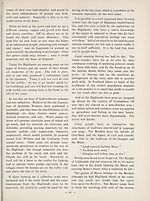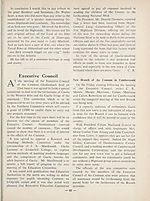An Comunn Gàidhealach Publications > Gaidheal > Volumes 58--62(part), January, 1963--March 1967
(116) Page 82
Download files
Complete book:
Individual page:
Thumbnail gallery: Grid view | List view

and the loves of a country people. They have
lost the deep fervour of religious feeling which
characterised the Borders at the time of the
Covenant. This must always happen, because
a people are never able to sustain such a high
pitch of emotion for a long period, and where a
people are situated between two great industrial
areas the influence and ideas of the great outside
passing through moderates both the laws of
religion and superstition.
But superstitions are still there. They are the
remains of an old tradition and do not die out
easily. They are retained by the women folk,
who as the cradle of the race seem to cherish
them. Men like to be conventionally material¬
istic, but the old latent fear of the unknown is
in every man although it is stepped according
to his environment, and his nearness to nature.
It only needs the instance to bring it out.
The “ White Lady of Tarras ” the “ Fairy
Loup,” the “ Wizard Brew,” of Soulis of
Hermitage are all indicative of what the past has
been. Today Hollywood brews up Franken-
steins, Snow Whites, and Seven Dwarfs, by the
hundred yard of celluloid tape ; and so the past
is forgotten in our full speed present, which
pretends not to believe in mysteries beyond
man’s narrow ken, but which is still secretly
afraid of them.
The Highlander is essentially an idealist and
his history records the subordination of material
values to the ideal of the spiritual. For centuries
he preferred war for independence to prosperity
and peace. When clan wars were over some of
them sacrificed everything for the theory of the
legitimate succession of Prince Charles Edward.
It is doubtless very true that there are many
facets to a character such as this. There is a
love of fighting, dourness of spirit, and a loyalty
and pride which overcomes all substantial and
concrete values.
Taken all in all throughout the tangles and
troubled story of the Gael runs a convincing
inner thread that the things that are unseen are
eternal, and that the life of the body is small
recompense for the enslavement of the spirit.
It is probably this that spelt the end of ventures
in the Highlands.
The Highland nature at home is wary and
suspicious of intrusion and yet this nature
abroad has in it the essence of adventure which
carries it beyond the ordinary pale. A Keith
led the armies of Frederick the Great in a hot
fire of victory through Europe ; Highlanders
scaled the cliffs of Abraham with Wolfe and
captured Quebec ; and they have played a great
part in the pioneering of Africa, Canada,
Australia, and New Zealand.
Their language is beautiful in its diction,
wide in its expression of emotion. Their songs
and legends date back to Fionn and Ossian,
handed down by word of mouth from the
senechals of the clans. Their music has in it
the exquisite pathos of the lament, and the
fierce lilting fire of the strathspeys and reels.
Their lives were once wild and gay, wild with the
flame of battle, gay as the dancing rill.
When the Calvinistic doctrine of the Reforma¬
tion hit the Isles and the Highlands it had a far
reaching effect. It was pressed forward with
zeal and vigour and in its course it swept a lot
of the happiness and joviality that had character¬
ised the people before it. Singing, dancing, and
entertainment were considered by the strictest
adherents to be sinful and we find this outlook
even in some parts of the Highlands today.
The Church became dependent on the estate
owners, with the result that during the Highland
Clearances, many ministers advocated the evils
of forced emigration as acts of God. Today the
people are taking a broader view of life, but the
remains of the Calvinistic, outlook can still be
found in a theoretic phase of religion and
religious schisms which is not applied as a way
of life. Nevertheless Calvinism in spite of its
shortcomings produced some outstanding men
of its age in the Highlands, and the Church
in our day can do a great work in restoring
the old spirit of the people.
Folklore and superstition still abound side
by side with religion : and second sight, pre¬
monition, and warnings of the future are believed.
Some of the mythology of the old Celts still
remain ; Tir nan Og was the land of the ever
young, and the Celtic hell was the cold of frozen
desolation. The Highlander believed in jovial
funerals and jovial marriages. The funerals
have now been toned down but the marriages
are still the same.
— 82 —
lost the deep fervour of religious feeling which
characterised the Borders at the time of the
Covenant. This must always happen, because
a people are never able to sustain such a high
pitch of emotion for a long period, and where a
people are situated between two great industrial
areas the influence and ideas of the great outside
passing through moderates both the laws of
religion and superstition.
But superstitions are still there. They are the
remains of an old tradition and do not die out
easily. They are retained by the women folk,
who as the cradle of the race seem to cherish
them. Men like to be conventionally material¬
istic, but the old latent fear of the unknown is
in every man although it is stepped according
to his environment, and his nearness to nature.
It only needs the instance to bring it out.
The “ White Lady of Tarras ” the “ Fairy
Loup,” the “ Wizard Brew,” of Soulis of
Hermitage are all indicative of what the past has
been. Today Hollywood brews up Franken-
steins, Snow Whites, and Seven Dwarfs, by the
hundred yard of celluloid tape ; and so the past
is forgotten in our full speed present, which
pretends not to believe in mysteries beyond
man’s narrow ken, but which is still secretly
afraid of them.
The Highlander is essentially an idealist and
his history records the subordination of material
values to the ideal of the spiritual. For centuries
he preferred war for independence to prosperity
and peace. When clan wars were over some of
them sacrificed everything for the theory of the
legitimate succession of Prince Charles Edward.
It is doubtless very true that there are many
facets to a character such as this. There is a
love of fighting, dourness of spirit, and a loyalty
and pride which overcomes all substantial and
concrete values.
Taken all in all throughout the tangles and
troubled story of the Gael runs a convincing
inner thread that the things that are unseen are
eternal, and that the life of the body is small
recompense for the enslavement of the spirit.
It is probably this that spelt the end of ventures
in the Highlands.
The Highland nature at home is wary and
suspicious of intrusion and yet this nature
abroad has in it the essence of adventure which
carries it beyond the ordinary pale. A Keith
led the armies of Frederick the Great in a hot
fire of victory through Europe ; Highlanders
scaled the cliffs of Abraham with Wolfe and
captured Quebec ; and they have played a great
part in the pioneering of Africa, Canada,
Australia, and New Zealand.
Their language is beautiful in its diction,
wide in its expression of emotion. Their songs
and legends date back to Fionn and Ossian,
handed down by word of mouth from the
senechals of the clans. Their music has in it
the exquisite pathos of the lament, and the
fierce lilting fire of the strathspeys and reels.
Their lives were once wild and gay, wild with the
flame of battle, gay as the dancing rill.
When the Calvinistic doctrine of the Reforma¬
tion hit the Isles and the Highlands it had a far
reaching effect. It was pressed forward with
zeal and vigour and in its course it swept a lot
of the happiness and joviality that had character¬
ised the people before it. Singing, dancing, and
entertainment were considered by the strictest
adherents to be sinful and we find this outlook
even in some parts of the Highlands today.
The Church became dependent on the estate
owners, with the result that during the Highland
Clearances, many ministers advocated the evils
of forced emigration as acts of God. Today the
people are taking a broader view of life, but the
remains of the Calvinistic, outlook can still be
found in a theoretic phase of religion and
religious schisms which is not applied as a way
of life. Nevertheless Calvinism in spite of its
shortcomings produced some outstanding men
of its age in the Highlands, and the Church
in our day can do a great work in restoring
the old spirit of the people.
Folklore and superstition still abound side
by side with religion : and second sight, pre¬
monition, and warnings of the future are believed.
Some of the mythology of the old Celts still
remain ; Tir nan Og was the land of the ever
young, and the Celtic hell was the cold of frozen
desolation. The Highlander believed in jovial
funerals and jovial marriages. The funerals
have now been toned down but the marriages
are still the same.
— 82 —
Set display mode to:
![]() Universal Viewer |
Universal Viewer | ![]() Mirador |
Large image | Transcription
Mirador |
Large image | Transcription
| An Comunn Gàidhealach > An Comunn Gàidhealach Publications > Gaidheal > Volumes 58--62(part), January, 1963--March 1967 > (116) Page 82 |
|---|
| Permanent URL | https://digital.nls.uk/127150173 |
|---|
| Description | This contains items published by An Comunn, which are not specifically Mòd-related. It includes journals, annual reports and corporate documents, policy statements, educational resources and published plays and literature. It is arranged alphabetically by title. |
|---|
| Description | A collection of over 400 items published by An Comunn Gàidhealach, the organisation which promotes Gaelic language and culture and organises the Royal National Mòd. Dating from 1891 up to the present day, the collection includes journals and newspapers, annual reports, educational materials, national Mòd programmes, published Mòd literature and music. |
|---|---|
| Additional NLS resources: |
|

